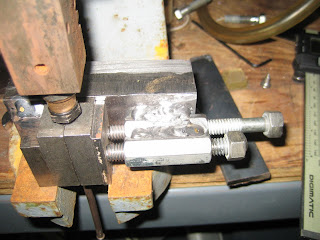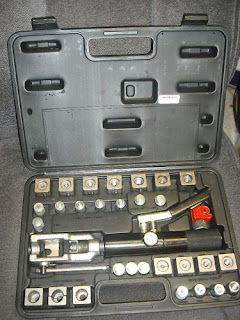I replaced a bunch of the 4.75mm lines recently, and I used the Cunifer brake line from Fed Hill. This is a copper-nickel alloy brake line, about $55USD for 25ft from Fed Hill, and $80Cdn at Napa for the same amount. The material is really nice - forms beautifully (though it work hardens quickly - you can torch-anneal quite easily, but not after there is brake fluid in it!), does not corrode - but what the hell! the fittings don't come in stainless - so what is the point of having a line that doesn't corrode when the fittings will? I searched far and wide on the internet for stainless DIN/ISO metric bubble flare tube nuts - None whatsoever. I'm thinking maybe I should make some and market them. All the ones I could find are Zinc-chromated steel. In fact, no stainless tube nuts of any style at all. There were brass unions, but no brass tube nuts......wonder why?
So, the goal of replacing brake lines with premium copper-nickel lines became an excercise in working to eliminate any fittings (use long continuous lines, without intermediate joints, and locate joints in protected areas), and where there are fittings, provide slack - so you can remove the rusted steel fitting by cutting off the end of the formed tube, then put a new one, and reform the tube end.
Anyway, This was a big job for me - working with the car jacked up on stands (no lift at home - yet).
Fed Hill makes a pretty cool looking flaring tool for about $300 - but it is a bench-top tool, which I think is an issue. There is a UK company making the same style of tool for about 1/2 the price - I would go with them first.
But since I didn't want to pay that much, I bought only the die from Fed Hill for about $40 and made a little vise to hold them while I formed the flare with my small arbor press. See pics below. The vise was made using a 220V Lincoln Mig welder from Canadian tire, couple of blocks of scrap steel, two 3/8" coupling nuts and two bolts of unequal length (otherwise there is no space to turn the nuts).
The dies from Fed Hill are long, and have no serrations inside - they are smooth-walled, and therefore leave no tooling marks on the tube. The added length probably improves the grip on the tubing.
Was not sure if this little vise and arbor press would work at first, but it works beautifully. Note how chunky my little vise is, and how it has two screw-clamps very close together. This allows me to place a lot of pressure on the die to grip the tube well. The position of the vise screws also allows adjustment of lateral pressure on the die. Without this feature, one half the die will always be a little cock-eyed in the clamp. There is space to add more vise screws, but two was enough - without a whole lot of pressure on the screws, they clamp the tube effectively. You can see in the first pic I have a bushing by the hardened steel die - it's used to keep that black steel die straight during forming.

The below pic is of the Mastercool flaring set kit #71745. This set can be had for about $320 USD on Ebay from retailers, or about $450 CDN from Value Tools in Toronto (located downstairs at Sheridan Mall - Jane and Wilson). I went and took a good look at this tool, and I can say I've learned a few things.
- It has the same weakness all the other tools do: Gripping the tube well enough. You can see the tool is really well designed otherwise (I love the compact hydraulic ram, which is small enough to use on-car), and the price shows it, but the clamp is still too dinky, with a single screw and a weak frame. The dies are also not as long as the dies I got from Fed Hill, and the dies have mild serrations in them as well. The Fed Hill die has none. I therefore decided not to buy it. Of course, struggling with my arbor press on-car was a hassle.
These are various flares:
On the right is a flare made with a cheap tool like the one in the previous post, leaving all kinds of teeth marks. The middle two are flares that come on pre-formed tubing you can buy from auto parts stores. The left-most is the copper-nickel tube flared by me with the arbor press and just a pair of vise grips holding the die blocks in the arbor press - it is slightly off-centre, but it was my first try, and with no stable die clamp. Later, using my little home-made vise, the flares were much better - as good as the ones from the store, and better. You can see the ones from the store vary a great deal.
I also tried with the green polymer-coated tubing, which is a significant step up in quality from the cheapest zinc-plated steel tubing. I found this material hard to work with, because the tubing is so slippery.







